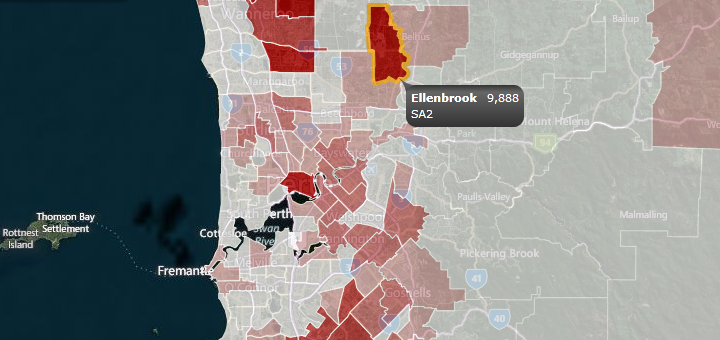If Australia’s population lived in one city, how large would that city be if it were as dense as… Melbourne? …Hobart? What if it had the same population density as Darwin? How far would that city stretch, and how would such a city function? Inspired by a similar exercise done for the population of the world, Nenad maps the ‘City of Australia’.
I was recently reminded of a series of maps I saw some years ago. The maps were made by Tim De Chant on the website/blog “Per Square Mile”. They were a very unique and attractive way to visualise the world’s population through the denominator of city densities.
Tim created several maps depicting the world’s population, concentrated. If the world’s (at the time) 6.9 billion people lived in one city, how large would that city be if it was as dense as Paris, San Francisco, New York, London, Singapore or Houston? He picked an approximate southern middle of the United States as a centroid for this fictional mega-city.
So what would this look like in Australia?
Australia is one of the biggest but least densely populated countries in the world. With Tim De Chant’s maps as the inspiration, I created maps showing Australia’s population, concentrated.
If Australia’s 24.9 million residents lived in one city, how large would that city be if it was as dense as each of Australia’s greater capital cities?
Using the location of Melbourne as a starting point and growing outwards, here is how dense the “City of Australia” would be depending on which greater capital city density we apply.
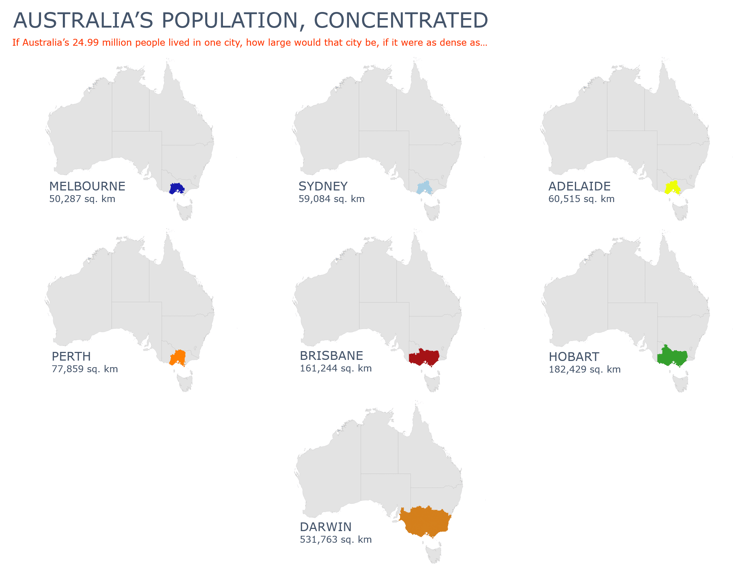
I’ve also made some detailed maps for Melbourne, Sydney, Adelaide, Perth, Brisbane, Hobart and Darwin.
What if Australia’s population all lived in…
..Melbourne?
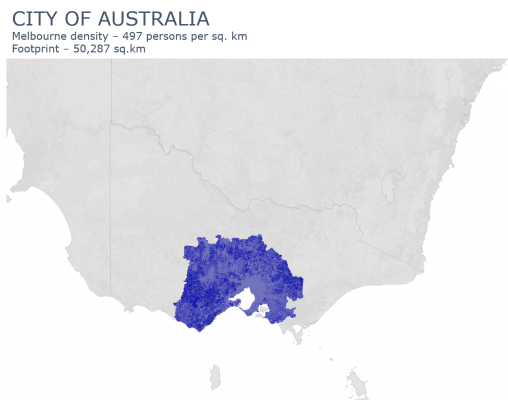
..Sydney?
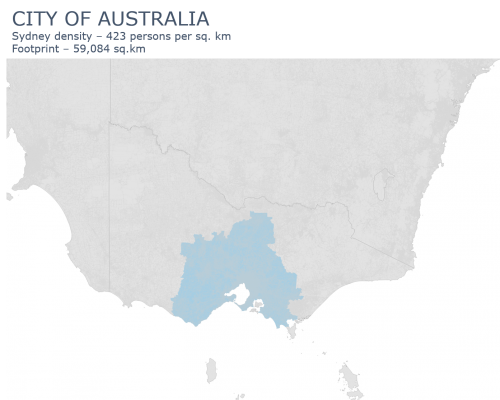
..Adelaide?
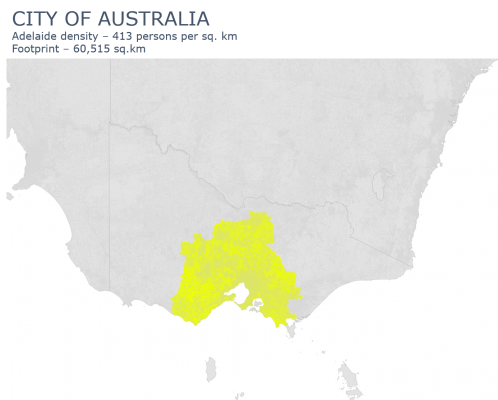
..Perth?
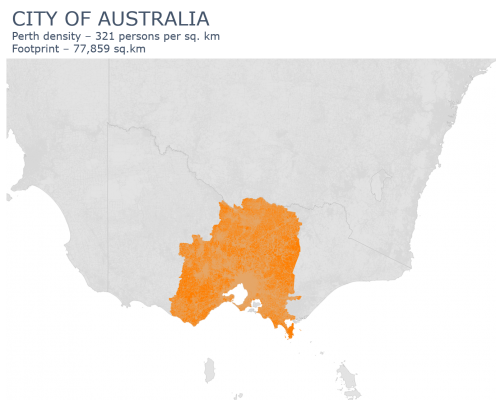
..Brisbane?
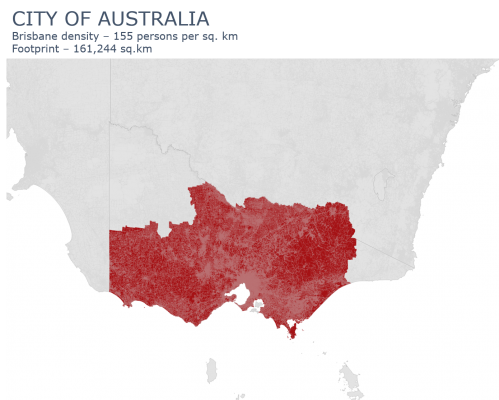
..Hobart?
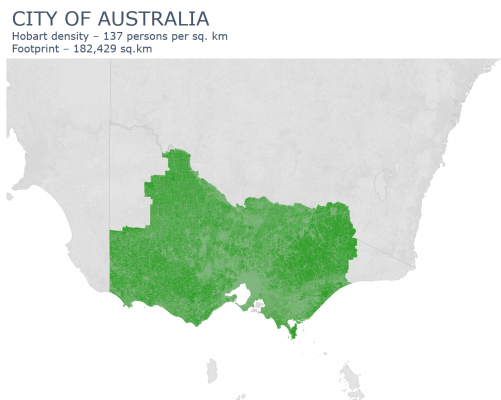
..Darwin?
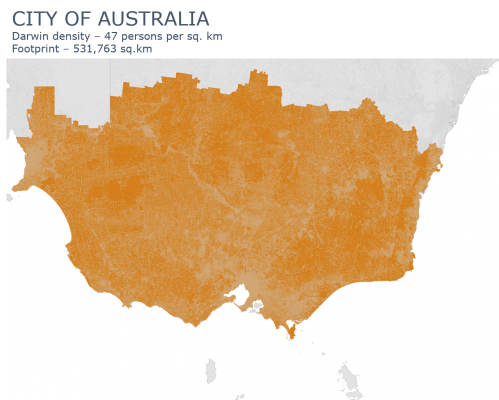
Cities with the density of Greater Melbourne (497 persons per sq. km), Sydney (423 p/sq.km ), Adelaide (413 p/sq.km) and Perth (321 p/sq.km) would all occupy similarly sized footprints, approximately extending to Shepparton, Cobram or even Echuca in the north, Camperdown in the east and Traralgon in the west.
However, our City of Australia doubles in size if it takes on Brisbane’s or Hobart’s population densities (155 and 137 p/sq.km respectively). These cities could cover an area as far east as the State border with South Australia, all the way north to Robinvale and out west to Corriyong and the Kosciuszko National Park.
The city footprint becomes a true megalopolis when Greater Darwin’s low population density of 47 persons per square kilometre is used. At this density, a city which contains all of Australia’s population would extend east far beyond Adelaide to Petersborough in South Australia, all the way to Cowra in the north and include the entire ACT and to Kiama, almost on the doorstep to Wollongong in the west.
How would these cities function?
For me, Tim’s maps provoke a few thoughts and questions. They illustrate the density differences of some well-known cities. Houston, for example, has a population of 6.9 million and Paris, a population of 12.5 million (metro areas) – yet Houston’s population density is only around a seventh of Paris’ density so the fictional city with Houston’s density would be vastly larger than a Paris-density city.
The maps also make you wonder – what would these cities look like? How would they operate, how would communities interlink? How would the cities interact with the natural environment within and around them? What kind of social cohesion would this city have? Can you imagine 6.9 billion people crammed into 331,000 square kilometres covering most of Louisiana, Arkansas and Mississippi? The challenges for a city that dense covering an area that large would be huge.
What about the gigantic Houston-density footprint? I almost wonder if the denser, smaller city would function more efficiently than the larger, more spread out one? Surely the only way this mega city could function would be if it was, in fact, a collection of smaller component cities, each with their own employment hubs, social networks and (relatively) nearby housing. Each one of these component cities would have different densities within themselves: a high-density core, medium density middle with a few high-density nodes and a lower density outer ring.
Interesting, right?
Nenad is an experienced population forecaster and demographic consultant – you can read more of his recent work on his profile page.










